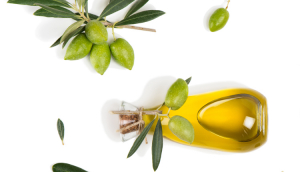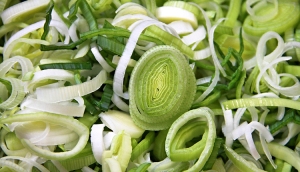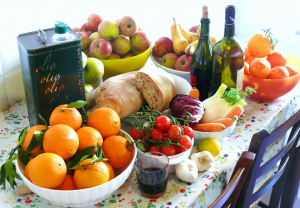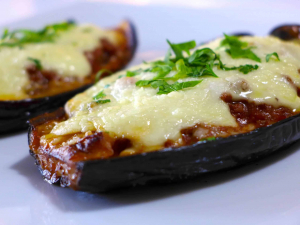WELLNESS HUB
XpatAthens
Fried Feta With Sesame Seeds And Honey
- 250g feta cheese (9 ounces)
- 2 eggs
- 1 tsp of paprika
- 1 tsp of freshly ground pepper
- 70-80g of flour, enough to coat the feta (3 ounces)
- 160g sesame seeds
- Olive oil for frying
- 4 tbsps of honey
Interesting Facts About Greek Olive Oil
Olive oil is an essential ingredient in Greek cuisine and an integral part of the Mediterranean diet – which is considered the healthiest in the world!
1. Greece is the 3rd largest olive oil producer in the world and the biggest exporter of extra virgin olive oil. Greek extra virgin olive oil is even exported to other oil producing countries such as Italy and Spain.
3. Each Greek person consumes an average of 26 liters of olive oil a year!
4. A mature olive tree will produce 15- 20 kilos of olives each year. It takes about 5 kilos of olives to make a liter of oil; therefore, an olive tree yields 3-4 liters of oil each year.
5. Extra virgin olive oil has a delicious, clean flavor and is produced from the first pressing of the olives without any use of solvents, and in specific temperatures that will not degrade the oil.
6. The fresher the olive oil is, the better it tastes. After about a year, it's best to use the oil for cooking, while keeping the fresher oil for dressing salads and other cold uses.
7. Olive oil has a high content of monounsaturated fats; studies have shown that replacing saturated fats with monounsaturated fats, can lower the risk of coronary heart disease.
8. It is a proven fact that olive oil helps reduce bad cholesterol (LDL) and increases the level of good cholesterol (HDL).
9. Olive oil is very high in oleic acid, which helps reduce blood pressure and contains several antioxidants such as vitamin E, carotenoids, and oleuropein.
This content has been sourced and prepared by Codico Lab
3 Delicious Summer Smoothies
Serves: 1
Difficulty: Easy
Cooks in: 5 min
Ingredients
Peanut Butter & Banana Smoothie
• 200 ml of coconut milk
• 1 tsp peanut butter
• 1 tsp honey
• 1 banana, peeled
• 1tsp grated chocolate
Melon & Cucumber Smoothie with Mint
• 150 g strained yogurt
• 2 slices melon, chopped
• 1 small cucumber, chopped
• 20 ml maple syrup
• 3 fresh mint leaves and some extra leaves for garnishing
Mixed Berry & Pineapple Smoothie
• 200 ml of milk
• 90 g berries (frozen) and some extra berries for garnishing
• 100 g pineapple, chopped
• 1 tbs berry marmalade
Cooking Instructions
Peanut Butter & Banana Smoothie
In a blender combine the coconut milk, the peanut butter, the banana, and the honey and blend until smooth. Serve in a glass and garnish with grated chocolate.
Melon & Cucumber Smoothie with Mint
In a blender add the cucumber, the melon, a few leaves of mint, the yogurt and the maple syrup and blend until smooth. Serve in a glass and garnish with mint leaves.
Mixed Berry & Pineapple Smoothie
In a blender combine the milk, the pineapple, and the marmalade and blend until smooth. Serve in a glass and garnish with berries.
Fanouropita – A Cake For Finding Lost Things
Yield: 1 cake (25cm)
Difficulty: Intermediate
Cooks in: 1 hour and 20 minutes
Ingredients
- 450g of flower
- 260g of sugar
- 1 cup of olive oil
- 1 cup and 2 tbsp of orange juice
- 100g of walnuts
- 90g of raisins
- 4g of powdered cinnamon
- 1 tsp of powdered cloves
- 20g of baking powder
- 1 tsp of salt
- 1 tbsp of red wine vinegar
- Icing sugar for dusting (optional)
Greek Semolina Halva
Serves: 8-10
Difficulty: Intermediate
- 3/4 cups sunflower oil
- 1 cup coarse semolina
- 1 cup fine semolina
- 3 cups granulated brown sugar
- 4 cups water
- Zest of 3 oranges
- 1 teaspoon ground cinnamon
- 1/4 teaspoon ground cloves
- 1 teaspoon vanilla extract
- 150 g almond slivers
2. Toast the almond slivers in a shallow baking pan lined with parchment paper for 5-8 minutes.
3. In a non-stick pot saute the vegetable oil with the fine semolina and coarse semolina, over medium-low heat.
4. Stir the mixture continuously for about 4-5 minutes, until the semolina becomes golden brown. Do not rush this process since semolina burns easily. Sauteeing the semolina gives it a rich and nutty flavor.
5. When ready, add the sugar, water, orange zest, cinnamon, and cloves.
6. Stir for another 10 minutes until the mixture thickens and starts to bubble. You will know it is ready when it starts to pull away from the bottom of the pan.
7. Add the almonds and continue to stir.
8. Transfer the mixture into a 22 cm bundt cake pan, hit the cake pan on a hard surface to make sure the mixture settles and your halva is nice and compact.
9. Turn it over after 5 minutes.
Find this and other great recipes on: akispetretzikis.com
Prassopita: Leek And Feta Pie
Difficulty: Easy
Cooks in: 90 minutes
• 2 onions
• 4 tablespoons olive oil
• 3 sticks celery
• 1 garlic clove
• salt
• pepper
• 3 spring onions
• 1/2 bunch mint
• 1/2 bunch dill
• the zest of 1 lemon
• lemon juice, of 1/2 lemon
• 300 g feta cheese
• 1 egg
• 700 g phyllo pastry
• 100 g olive oil, for brushing
Preparation
Preheat oven to 160 C (320F) Fan.
Place a pot of water over high heat. Add salt and bring to a boil. Chop the leeks into 1-2 cm rounds and add them to the pan. Let them boil for 2-3 minutes to remove the bitter taste that comes from the green part of the leeks
Drain and place the same pan over high heat. Let it get hot. Coarsely chop the onions. Add 4 tablespoons of olive oil to the hot pan. Add the onions and leeks and sauté. Chop the celery into rounds, mince the garlic and add both to the pan.
Season with salt, stir often and sauté for 10-15 minutes until they caramelize nicely. Transfer the sautéd vegetables to a bowl and add finely chopped spring onions, mint, and dill. Add the pepper, lemon zest, and lemon juice.
Crumble the feta cheese with your hands and add it to the bowl. Finally, add the egg and mix until all of the ingredients are completely combined.
To learn how to use phyllo pastry to complete this recipe, please visit: akispetrtzikis.com
Weigh Loss Surgeon Praises Mediterranean Diet
Watermelon Granita - The Perfect Drink To Survive The Heatwave
Yield: 4-6 servings
Difficulty: Easy
Ready in: 6 hours
- 150 g water
- 150 g brown sugar
- 800 g watermelon, cleaned
- 1 teaspoon(s) vanilla extract
- lemon juice from 1 lemon
- lemon zest from 1 lemon
- sliced watermelon for decor
- In a pot, add the water with the sugar and place it over medium heat for about 2 minutes.
- As soon as it starts bubbling, let it boil for 2-3 minutes, and then remove from heat. Set the syrup aside to cool.
- Cut the watermelon into 2-3 cm pieces and puree them along with the syrup, the vanilla extract, and the lemon zest and juice into a blender.
- Share the mixture into ice-cube trays and freeze them for 5-6 hours.
- When they freeze well and you are about to serve them, pour the ice cubes into the blender and puree them until they look like snow.
- Fill the glasses and serve with watermelon slices.
Great Reasons To Add Greek Yogurt To Your Daily Diet
Greek Stuffed Eggplant Recipe
- 5 eggplants
- 500g minced beef
- 1 large red onion, finely chopped
- 2 cloves of garlic, finely chopped
- 1 glass of red wine
- 1 tin chopped tomatoes or tomato juice (passata)
- 1 cinnamon stick
- 1 tsp oregano
- 100g grated kefalotyri or any hard yellow cheese
- olive oil
- salt
- freshly ground pepper
- 2–3 tbsps chopped parsley
- 100g flour
- 100g butter
- 900ml milk (3 and 3/4 cups)
- 2 egg yolks
- a pinch of nutmeg
- 4 large potatoes, boiled
- 50g milk
- 1 tbsp butter
- 2 egg yolks
- Cut the eggplants into two pieces and carve them crosswise (the flesh). Season the eggplants and place them in a colander for about half an hour. Wash them with plenty of water and drain them on some kitchen paper.
- Preheat the oven to 200C. Season the eggplants with salt and pepper and drizzle with olive oil. Place the eggplants (with the skin facing up) in a baking tray, lined with parchment paper. Bake the eggplants for 40 minutes, until softened.
- In the meantime, prepare the meat sauce for the ‘papoutsakia’. Peel and chop the onions and garlic. Place a large pan on medium heat, add some olive oil and the onions and sauté, until softened. Stir in the garlic and sauté. Turn the heat up, add the minced beef breaking it up with your spoon and sauté. Deglaze with the red wine and wait 1-2 minutes to evaporate. Stir in the canned tomatoes, the cinnamon stick, a pinch of sugar, the oregano, and season. Bring to the boil, turn the heat down and simmer with the lid on for about 30 minutes, until most of the juices have evaporated. In the end, add 1-2 handfuls of grated cheese and chopped parsley and stir.












